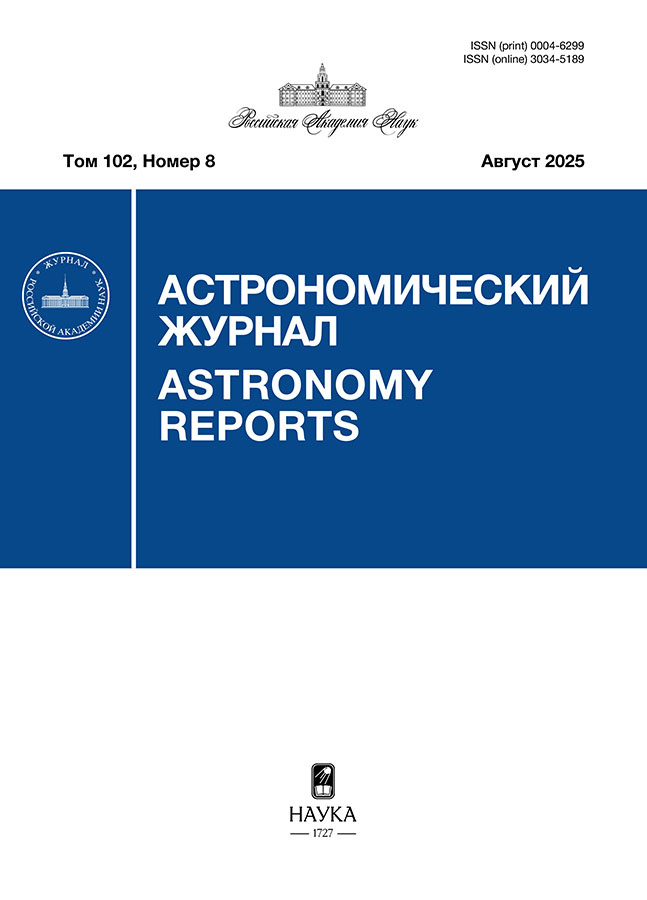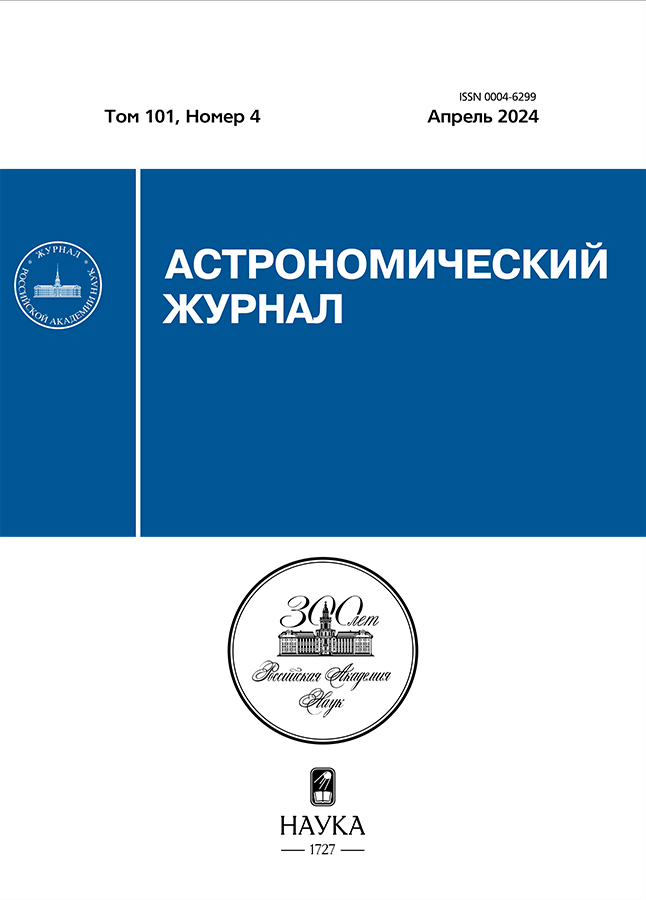Экспериментальное исследование влияния УФ-излучения на активацию имитаторов пылевых частиц реголита безатмосферных тел
- Авторы: Кузнецов И.А.1, Шашкова И.А.1, Ляш А.Н.1, Поройков А.Ю.2, Бедняков С.А.1,3, Кронрод Е.В.4,5, Дольников Г.Г.1, Дубов А.Е.1, Вощан О.Н.1, Абделаал М.Э.1,6, Попель С.И.1, Морозова Т.И.1, Карташева А.А.1, Столяренко П.В.3, Тянь Я.Y.2, Захаров А.В.1, Зеленый Л.М.1
-
Учреждения:
- Институт космических исследований Российской академии наук
- Национальный исследовательский университет «МЭИ»
- Московский государственный университет им. М. В. Ломоносова
- Институт геохимии и аналитической химии им. В. И. Вернадского Российской академии наук
- Казанский (Приволжский) федеральный университет
- Московский физико-технический институт
- Выпуск: Том 101, № 4 (2024)
- Страницы: 335-347
- Раздел: СТАТЬИ
- URL: https://gynecology.orscience.ru/0004-6299/article/view/647607
- DOI: https://doi.org/10.31857/S0004629924040044
- EDN: https://elibrary.ru/KFTKXO
- ID: 647607
Цитировать
Полный текст
Аннотация
Начиная с первых автоматических миссий к Луне, была зарегистрирована активность пылевых частиц безатмосферных тел. С тех пор проведено множество теоретических и экспериментальных исследований этого эффекта, однако в настоящее время нет четкого понимания роли внешних воздействий на динамику этого явления. В данной работе представлены результаты экспериментов по определению влияния жесткого УФ-излучения на активность пылевых частиц. Показано, что оно вносит значительный вклад в динамику частиц. Результаты определения условий отрыва частиц от поверхности находятся в соответствии с теоретическими расчетами.
Полный текст
Об авторах
И. А. Кузнецов
Институт космических исследований Российской академии наук
Автор, ответственный за переписку.
Email: kia@cosmos.ru
Россия, Москва
И. А. Шашкова
Институт космических исследований Российской академии наук
Email: kia@cosmos.ru
Россия, Москва
А. Н. Ляш
Институт космических исследований Российской академии наук
Email: kia@cosmos.ru
Россия, Москва
А. Ю. Поройков
Национальный исследовательский университет «МЭИ»
Email: kia@cosmos.ru
Россия, Москва
С. А. Бедняков
Институт космических исследований Российской академии наук; Московский государственный университет им. М. В. Ломоносова
Email: kia@cosmos.ru
Научно-исследовательский институт ядерной физики им. Д. В. Скобельцына
Россия, Москва; МоскваЕ. В. Кронрод
Институт геохимии и аналитической химии им. В. И. Вернадского Российской академии наук; Казанский (Приволжский) федеральный университет
Email: kia@cosmos.ru
Россия, Москва; Казань
Г. Г. Дольников
Институт космических исследований Российской академии наук
Email: kia@cosmos.ru
Россия, Москва
А. Е. Дубов
Институт космических исследований Российской академии наук
Email: kia@cosmos.ru
Россия, Москва
О. Н. Вощан
Институт космических исследований Российской академии наук
Email: kia@cosmos.ru
Россия, Москва
М. Э. Абделаал
Институт космических исследований Российской академии наук; Московский физико-технический институт
Email: kia@cosmos.ru
Россия, Москва; Долгопрудный
С. И. Попель
Институт космических исследований Российской академии наук
Email: kia@cosmos.ru
Россия, Москва
Т. И. Морозова
Институт космических исследований Российской академии наук
Email: kia@cosmos.ru
Россия, Москва
А. А. Карташева
Институт космических исследований Российской академии наук
Email: kia@cosmos.ru
Россия, Москва
П. В. Столяренко
Московский государственный университет им. М. В. Ломоносова
Email: kia@cosmos.ru
Факультет космических исследований
Россия, МоскваЯ. Тянь
Национальный исследовательский университет «МЭИ»
Email: kia@cosmos.ru
Россия, Москва
А. В. Захаров
Институт космических исследований Российской академии наук
Email: kia@cosmos.ru
Россия, Москва
Л. М. Зеленый
Институт космических исследований Российской академии наук
Email: kia@cosmos.ru
Россия, Москва
Список литературы
- J. E. Colwell, S. Batiste, M. Horányi, S. Robertson, S. Sture, Rev. Geophys. 45, RG2006 (2007).
- D. R. Criswell Photon and Particle Interactions with Surfaces in Space (Springer, New York, edited by R. J. L. Grard, pp. 545–556, 1973).
- J. J. Rennilson and D. R. Criswell, Moon 10 (1974).
- H. Zook and J. McCoy, Geophys. Res. Lett. 18, 11 (1991).
- J. R. Gaier The Impact of Lunar Dust on Human Exploration (Cambridge Scholars Publishing, edited by J. S. Levine, pp. 67–87, 2021).
- S. I. Popel, L. M. Zelenyi, A. P. Golub’, A. Yu. Dubinskii, Planet. Space Sci. 156 (2018).
- X. Wang, M. Horányi, S. Robertson, J. Geophys. Res. 114, A05103 (2009).
- N. Ding, J. Wang, J. Polansky, IEEE Trans. Plasma Sci. 41, 12 (2013).
- T. M. Flanagan and J. Goree, Phys. Plasmas 13, 12 (2006).
- C. M. Hartzell and D. J. Scheeres, J. Geophys. Res. 118 (2013).
- T. E. Sheridan, J. Goree, Y. T. Chiu, R. L. Rairden, J. A. Kiess-ling, J. Geophys. Res. 97, A3 (1992).
- X. Wang, M. Horányi, S. Robertson, J. Geophys. Res. 115, A11102 (2010).
- X. Wang, M. Horányi, S. Robertson, Planet. Space Sci. 59, 14 (2011).
- X. Wang, J. Schwan, N. Hood, H. W. Hsu, E. Grün, and M. Hor’anyi, JoVE 134, e57072 (2018).
- А.Shu, A. Collette, K. Drake, E. Gün, M. Hor’anyi, S. Kempf, A. Mocker, T. Munsat, P. Northway, R. Srama, Z. Sternovsky, E. Thomas, Rev. Sci. Instrum. 83, 075108 (2012).
- I.Kuznetsov, S. L. G. Hess, A. V. Zakharov, F. Cipriani, E. Seran, S. I. Popel, E. A. Lisin, O. F. Petrov, G. G. Dolnikov, A. N. Lyash, S. I. Kopnin, Planet. Space Sci. 156, 62 (2018).
- J. Gu, X. Qian, Y. Liu, Q. Wang, Y. Zhang, X. Ruan, X. Deng, Y. Lu, J. Song, H. Zhang, Y. Dong, M. Wei, S. Li, W. H. Wang, Z. Zou, M. Yang, W. Yao, Research Square, (preprint), https://doi.org/10.21203/rs.3.rs-2923910/v1 (2023).
- N. C. Orger, K. Toyoda, H. Masui, M. Cho, Adv. Space Res. 68, 3 (2021).
- А.Carroll, N. Hood, R. Mike, X. Wang, H.-W. Hsu, M. Horányi, Icarus 352 (2020).
- Dust accelerator laboratory (dal), URL: https://impact.colorado.edu/facilities.html.
- J. I. Samaniego, X. Wang, L. Andersson, D. Malaspina, R. E. Ergun, and M. Hor’anyi, J. Geophys. Res. 123, 6054 (2018).
- N. Hood, A. Carroll, R. Mike, X. Wang, J. Schwan, H.-W. Hsu, and M. Hor’anyi, Geophys. Res. Lett. 45, 13206–13212 (2018).
- N. C. Orger, K. Toyoda, H. Masui, and M. Cho, Adv. Space Res. 63, 3270 (2019).
- А.Champlain, J. C. Mat’eo-V’elez, J. F. Roussel, S. Hess, P. Sarrailh, G. Murat, J. P. Chardon, and A. Gajan, J. Geophys. Res. 121, 103 (2016).
- А.V. Zakharov, A. Yu. Poroykov, S. A. Bednyakov, A. N. Lyash, I. A. Shashkova, I. A. Kuznetsov, G. G. Dolnikov, Measurement 171, 108831 (2021).
- I.W. Carrier, G. R. Olhoeft, and W. Mendell The Lunar Sourcebook (Cambridge University Press, edited by G. H. Heiken, D. T. Vaniman, and B. M. French, pp. 475–594, 1991).
- J. W. Freeman and M. Ibrahim, Moon 8 (1975).
- J. S. Halekas, G. T. Delory, R. P. Lin, T. J. Stubbs and W. M. Farrell, J. Geophys. Res. 113, A09102 (2008).
- С.N. Hartzell and D. J. Scheeres, Planet. Space Sci. 59 (2011).
- С.N. Hartzell, Aerospace Engineering Sciences Graduate Theses & Dissertations 48 (2012).
Дополнительные файлы





















